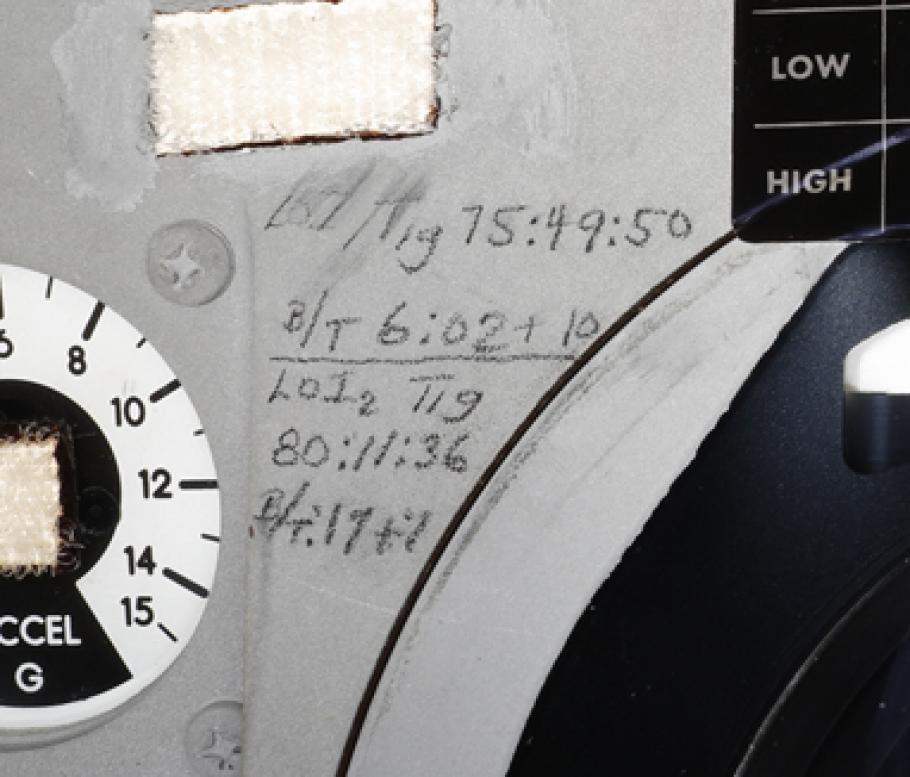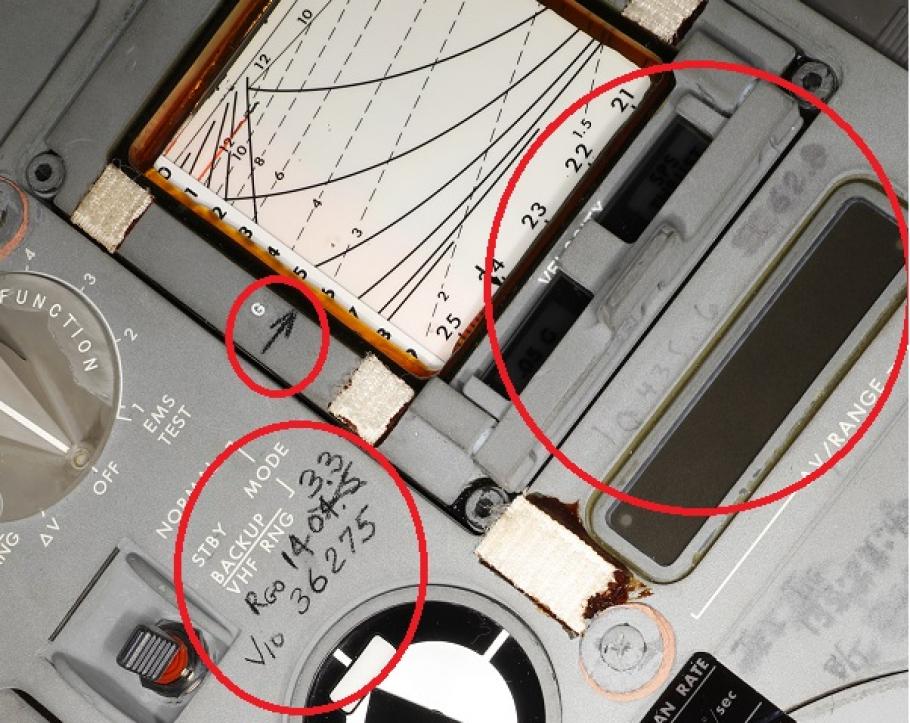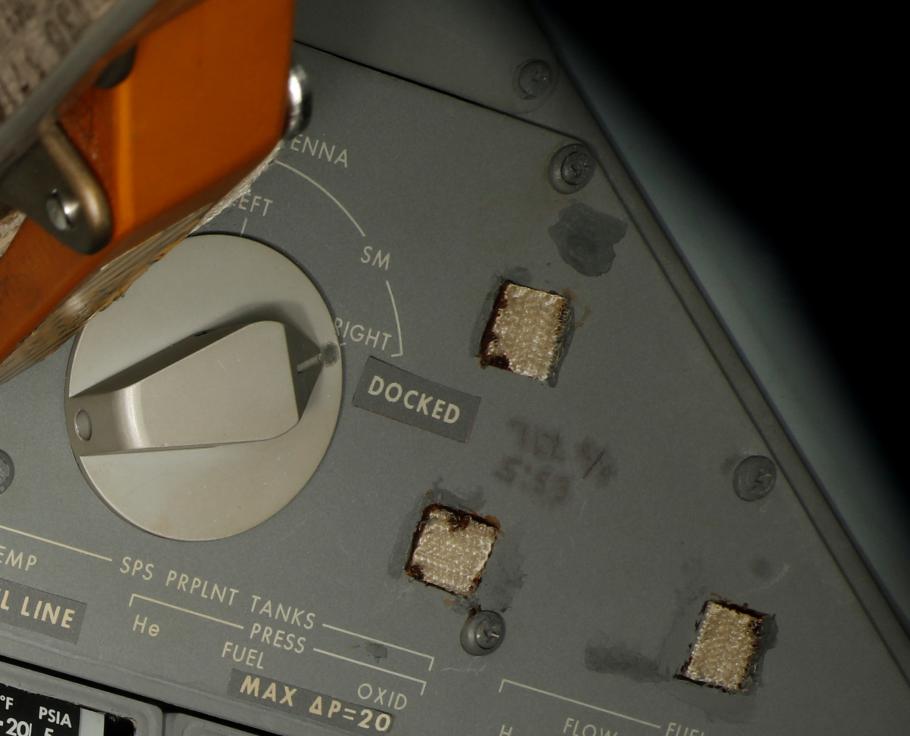
Investigating the Writing on Columbia’s Walls
Mar 03, 2016
I recently shared that we uncovered handwritten notes and markings inside the Apollo 11 Command Module Columbia—the spacecraft that carried astronauts Armstrong, Collins, and Aldrin into lunar orbit and home on their historic voyage of July 1969. As part of our collaboration with the Smithsonian’s Digitization Program Office to create a detailed 3D model of the spacecraft, we had access to previously inaccessible areas for the first time in many years.
We found notes written on a number of locker doors and even a small calendar used to check off days of the mission. We did our best to imagine the circumstances surrounding the creation of these markings. In the weeks that have passed, I have been working with an extraordinary team of experts to see what we can learn about each of the markings we documented, especially the more technical numerical entries. Today, we are posting the Apollo Flight Journal (AFJ) website, a detailed account of all the information we’ve gathered so far. The AFJ is a companion site to the Apollo Lunar Surface Journal hosted by the NASA history office. The full team of contributors is listed at the beginning of that posting. Their knowledge and dedication has been something to behold and I am deeply grateful to all of them. There has been significant progress interpreting the written words. Most directly, we have been in touch with Michael Collins and Buzz Aldrin. We can report that Mike, the Command Module pilot, confirmed that the small calendar was created by him. We also confirmed that wiping the walls was not a part of the planned disinfection process undertaken in the Lunar Receiving Laboratory after the mission. Beyond that, it has taken old-fashioned, detailed detective work to identify the context for each of the numerical entries. This work has been possible because of how thoroughly the technical aspects of the Apollo 11 mission have been documented in preserved checklists, mission plans, audio transcripts, and post-mission briefings. With all these references, and the unsurpassed knowledge of our team of collaborators, important conclusions can be reached. Please have a look at the full account on the AFJ site and feel free to share comments on any additions or corrections that occur to you. Elements that have not previously been discussed at length are the several numerical entries written directly on the Main Display Console (MDC). The MDC, commonly referred to as the Main Control Panel, is the impressive collection of switches, dials, and indicators mounted just above the astronauts when they are strapped into their seats.
Diagramed on this Apollo un-flown Main Display Console are the locations of markings that were found inside the the Apollo11 Command Module.
Notes were found in five different areas. Two groups are in the Flight Control portion on the left side—one near the Attitude Indicator and one near the Entry Monitoring System (EMS) Display Window. The third group of notes is in the central area of the MDC near the Reaction Control Systems area. The fourth and fifth groups of notes are, respectively, at the top and bottom-right of Panel 3 at the right-hand end of the MDC. As far as we can tell, these are all of the markings on the MDC.
Lunar Orbit Insertion Maneuver
We are able to associate each marking with a specific point of the mission. For example, just above the Attitude Indicator on Panel 1 (sometimes referred to as an eight ball), we have found a series of numbers related to a very important maneuver that took place some 75 hours into the mission. At that time, the service module propulsion system was used to change the spacecraft’s flightpath in order to enter into orbit around the Moon. The maneuver, not surprisingly, is called Lunar Orbit Insertion (LOI).
Markings on Apollo 11, Columbia capsule
What we see written is: LOI1 Tig 75:49:50 B/T 6:02 + 10 LOI2 Tig 80:11:36 B/T:17+1 The LOI maneuver required two separate engine firings; a long one and a short one. The desired parameters for each burn were relayed to the astronauts verbally in what was called a PAD, which stands for Preliminary Advisory Data. The PAD consists of a set of numbers relayed to the crew from Mission Control. They were always repeated back verbally to Mission Control to ensure the information was copied correctly. Mission Control had been tracking the spacecraft carefully and their computer analysis determined desired parameters for each of the engine firings. The PAD included the time of ignition, or Tig, which was 075:49:50. The estimated duration of the burn was 6:02. Similarly, numbers for the required second burn are written below. This information was relayed more than two hours in advance at 072:51:24 on the mission timer. You can read the transcripts of those communications here: Day 4, part 1: Entering Lunar Orbit. More details are contained in our report.
Earth Reentry Maneuver
A similar identification can be made of numerical entries related to the maneuver required to safely reenter the Earth’s atmosphere. Detail of the note at the bottom-left of the Entry Monitoring System window.
Detail of the note at the bottom-left of the Entry Monitoring System window.
The numbers in the lowermost circle as we see them are: RGO 1404.5 [4.5 crossed out, replaced above by 3.3 Vio 36275 The figure of 1404.5 was read as part of the entry PAD at 191:43:57 on the mission timer as recorded in the Apollo Flight Journal chapter Day 9: Re-entry and Splashdown. Later, at 194:16:57 in the mission, it was updated to a new value of 1403.3. The change is recorded on the panel. The number represents the distance in nautical miles that the spacecraft was expected to travel from the beginning of reentry to landing.
Translunar Injection Warning
The final example shows one way these entries illuminate how the astronauts actually operated. Near the upper-right corner of the Main Display Console is a small, somewhat faded entry.
Panel from the spacecraft.
The notation is: TLI c/o 5:53 Translunar Injection is the maneuver that took the spacecraft out of Earth orbit and sent it on its way to the Moon. The parameters of the required engine firing were read to the astronauts at 001:44:30 on the mission clock. Capsule Communicator (Capcom) Bruce McCandless passed the information to the crew. One of those numbers was the duration of the burn that they should expect their S-IVB stage (third stage on the Saturn V rocket) to make; i.e. 5 minutes and 47 seconds. It was likely that the engine on the S-IVB stage would slightly under- or over-perform and this time was only a guide. The goal was to achieve a certain velocity. In case the S-IVB failed to automatically shut down on time the crew had guide notes in the Flight Plan that told them when to perform a manual shutdown. Page 3-2a of their Flight Plan (below) carried a table of actions that the crew should take if something went wrong. One item told them that if the burn were to continue for six seconds beyond the time given in the PAD, they should manually shut it down.
Six seconds added to 5:47 gave a time of 5:53, and this is what Collins wrote in his field of view on the MDC so that he would be reminded to yell a shutdown instruction to Neil Armstrong if required. This is confirmed in the transcript of onboard conversations aboard Columbia. That exchange follows: 002:21:56 Collins (onboard): …Okay, Neil, now TLI: I'm going to write on the wall here - TLI - nominal is 5 plus 47. And 6 seconds later, it's 5 plus 53. And you want me to let you know when that is? I'll yell cut-off at that time. 002:22:27 Armstrong (onboard): Okay. 002:22:41 Collins (onboard): Is that right, Neil? 002:22:43 Armstrong (onboard): Yeah, that's right. 5:53, I want it yelled. 002:22:45 Collins (onboard): Okay. I'll yell cut-off, huh? 002:22:57 Armstrong (onboard): Yes, I guess. And I'll cut off if the G&N says... 002:23:04 Collins (onboard): Agreed. 002:23:05 Armstrong (onboard):...we're over-burned. 002:23:06 Aldrin (onboard): That's right. It is simply thrilling to be able to connect technical understanding of the mission with the voices of the astronauts and physical evidence left on the artifacts we have been so carefully preserving. Beginning this summer, when the first version the 3D model is scheduled for release on the Digitization Program Office website, we hope many others will be able to share in that thrill.
Related Topics
You may also like
Related Objects
We rely on the generous support of donors, sponsors, members, and other benefactors to share the history and impact of aviation and spaceflight, educate the public, and inspire future generations. With your help, we can continue to preserve and safeguard the world’s most comprehensive collection of artifacts representing the great achievements of flight and space exploration.








